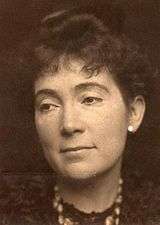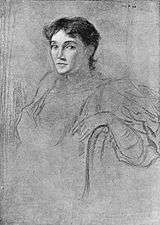John Oliver Hobbes
Pearl Mary Teresa Richards (November 3, 1867 – August 13, 1906) was an Anglo-American novelist and dramatist who wrote under the pen-name of John Oliver Hobbes. Though her work fell out of print in the twentieth-century, her first book Some Emotions and a Moral was a sensation in its day, selling eighty-thousand copies in only a few weeks.[1]

Early years
Pearl Mary Teresa Richards, born in Boston, Massachusetts, was the eldest daughter of the businessman John Morgan Richards and his wife Laura Hortense Arnold. Her father had Calvinist roots and her grandfather was a Presbyterian minister. The family moved to London soon after her birth, and she was educated in London and Paris.
Career
When she was nineteen, she married Reginald Walpole Craigie, by whom she had one son, John Churchill Craigie: but the marriage proved an unhappy one, and was dissolved on her petition in July 1895. She was brought up as a Nonconformist, but in 1892 was received into the Roman Catholic Church, of which she remained a devout and serious member. [2] Her successful career as a novelist and playwright also made her a popular socialite with as diverse associates as George Tyrrell and Aubrey Beardsley,[1] as well as George Moore, whose lover she had been.[3]
From 1900, Mrs Craigie lived and worked at her villa near her parents' home at St Lawrence, Isle of Wight. The villa is now called Craigie Lodge and bears a small commemorative plaque memorializing Mrs Craigie's time there.

Her first little book, the epigrammatic Some Emotions and a Moral, was published in 1891 in Mr Fisher Unwin's Pseudonym Library. With its accounts of unhappy marriage and infidelity, it was an immediate hit;[4] and was followed by similarly bohemian novels like The Sinner's Comedy (1892), A Study in Temptations (1893), A Bundle of Life (1894), The Gods, Some Mortals, and Lord Wickenham. The Herb Moon (1896), a country love story, was followed by The School for Saints (1897), with a sequel, Robert Orange (1900).
Her novels were guyed in a contemporary verse:
"John Oliver Hobbes, with your spasms and throbs, How does your novel grow? With cynical sneers at young Love and his tears, And epigrams all in a row".[4]
Mrs Craigie had already written a one-act proverb, Journeys end in Lovers Meeting, produced by Ellen Terry in 1894, and a three-act tragedy, Osbern and Ursyne, printed in the Anglo-Saxon Review (1899), when her successful piece, The Ambassador, was produced at the St James's Theatre in 1898. A Repentance (one act, 1899) and The Wisdom of the Wise (1900) were produced at the same theatre, and The Flute of Pan (1904) first at Manchester and then at the Shaftesbury Theatre; she was also part author of The Bishop's Move. (Garrick Theatre, 1902).[5] The first Act of her play "The Fool's Hour", written in collaboration with George Moore was published in Volume I of The Yellow Book, the leading journal of the 1890s, associated with Decadence and Aestheticism.[6]
Later books are The Serious Wooing (1901), Love and the Soul Hunters (1902), Tales about Temperament (1902), The Vineyard (1904).
An account of her friendship with Father (later Bishop) William Brown, based on volumes of their correspondence, was published by M.F. Brown as The Priest and the Playwright (Pen Press, 2009).
In 1906, she died suddenly of heart failure in London en route to a holiday in Scotland and is interred in Kensal Green Cemetery. [7] There is a memorial plaque to her in the Main Library of University College London, where she studied Greek, Latin and English Literature. It was unveiled in July 1908 by Lord Curzon of Kedleston.
Selected works
- Novels
- Some Emotions and a Moral, (1891)
- A study in Temptations, (1893)
- The Gods, Some Mortals, and Lord Wickenham, (1895)
- A Bundle of Life, (1894)
- Robert Orange, (1900)
- The Serious Wooing, (1901)
- Love and the Soul Hunters, (1902)
- The Vineyard, (1904); Flute of Pan, (1905)
- The Dream and the Business, (1906)
- Plays
- Journeys End in Lovers' Meeting, (1894), for Ellen Terry
- The Ambassador, (1898)
- A Repentance, (1899).
See also
References
- Harding 1996.
- Chisholm 1911.
- Martin Seymour-Smith, Hardy (1994) p. 472
- Martin Seymour-Smith, Hardy (1994) p. 477
- Clifford 1913.
- Yellow Nineties Online. Archived 2014-04-27 at the Wayback Machine
- "Steephill Castle, Ventnor, Isle of Wight, the residence of John Morgan Richards, Esq.; a handbook and a history", John B Marsh, privately published by Dangerfield Printing Company, 1907 (Internet Archive ark:/13960/t6g168955)
Attribution
- Clifford, Cornelius (1913). . In Herbermann, Charles (ed.). Catholic Encyclopedia. New York: Robert Appleton Company.
- Chisholm, Hugh, ed. (1911). . Encyclopædia Britannica (11th ed.). Cambridge University Press.
Bibliography
- J. M. Richards, Life of John Oliver Hobbes Told in her Correspondence with Numerous Friends, (New York, 1911)
- Mildred Davis Harding, Air-bird in the Water: The Life and Works of Pearl Craigie (John Oliver Hobbes), (New Jersey, 1996)
External links
- Finding aid to the Pearl Mary Teresa Craigie papers at Columbia University Rare Book & Manuscript Library
- Works by John Oliver Hobbes at Project Gutenberg
- Works by or about John Oliver Hobbes at Internet Archive
- Catholic Encyclopedia article
- Memorials and Monuments on the Isle of Wight
- Pearl Mary Teresa Craigie papers, 1894-1909, held by the Billy Rose Theatre Division, New York Public Library for the Performing Arts